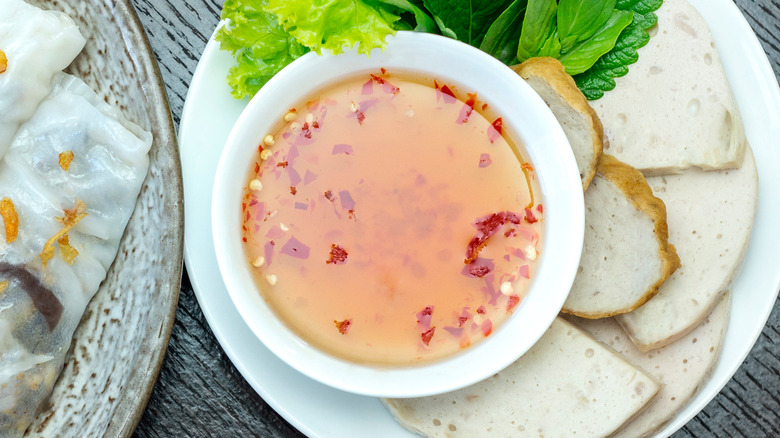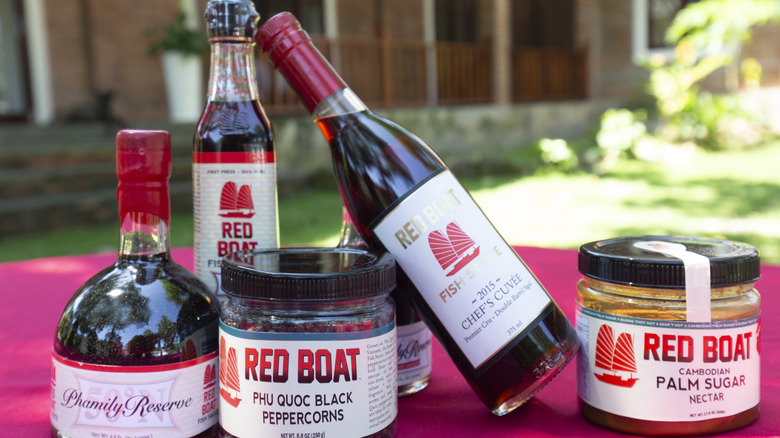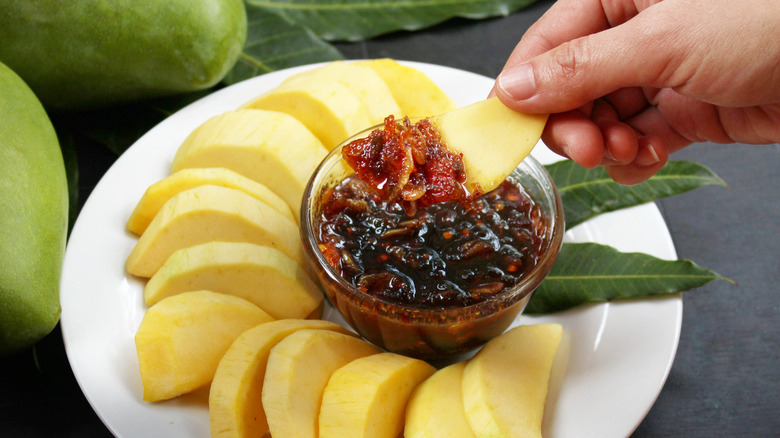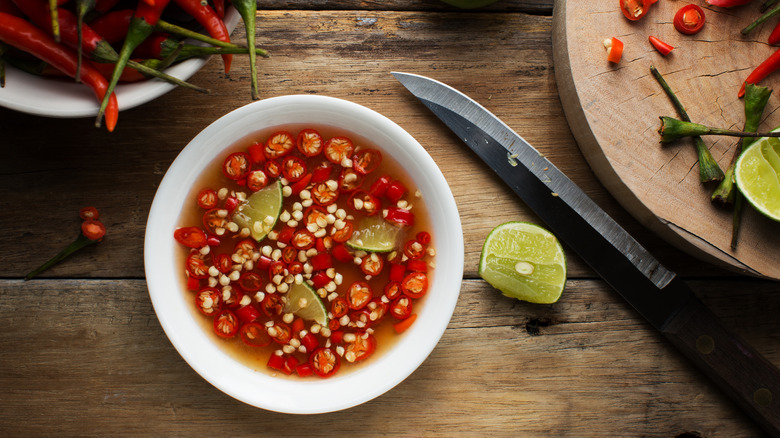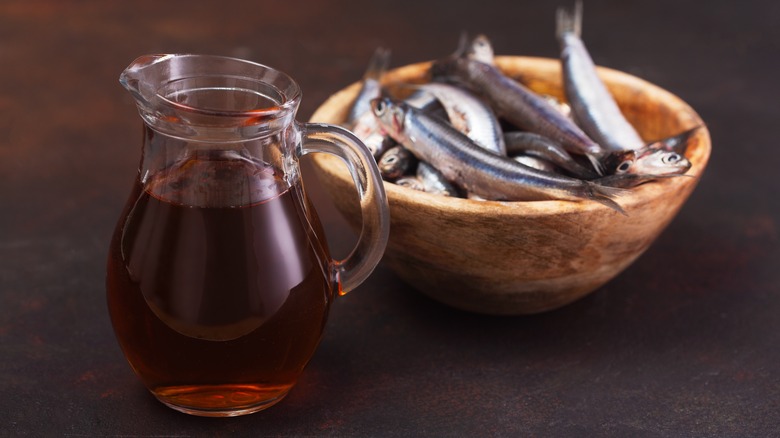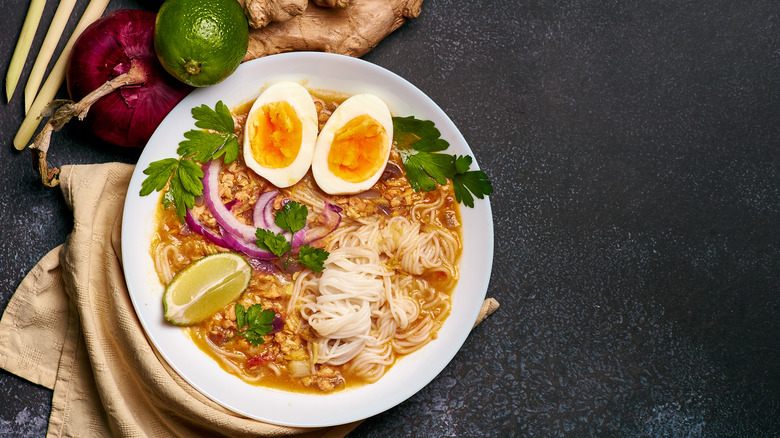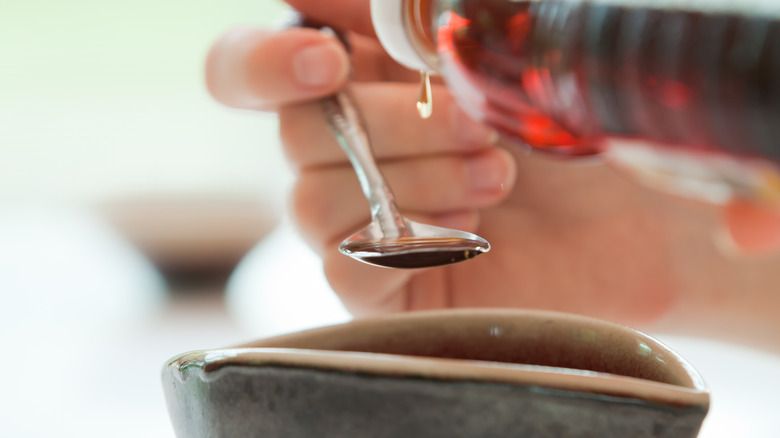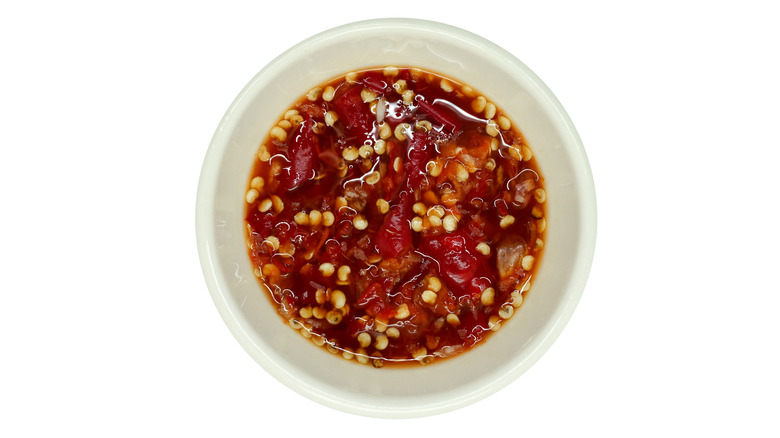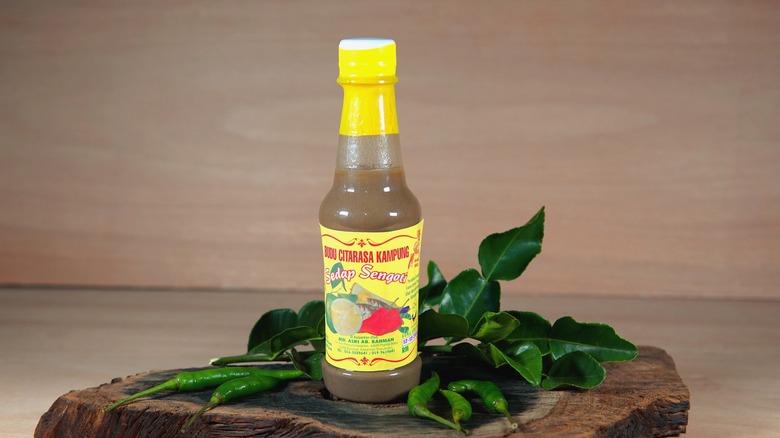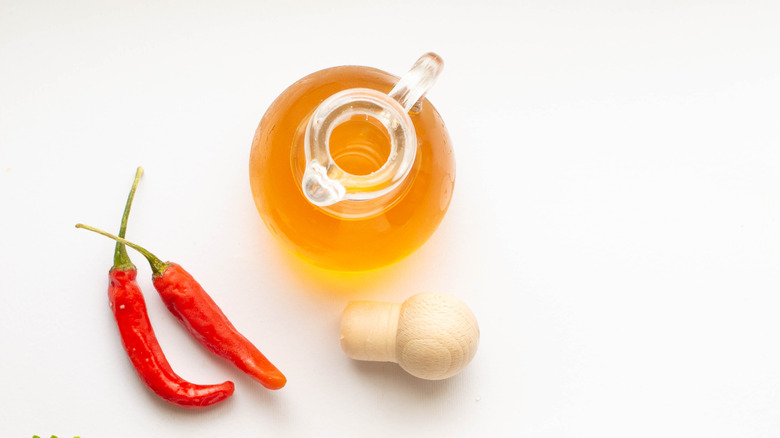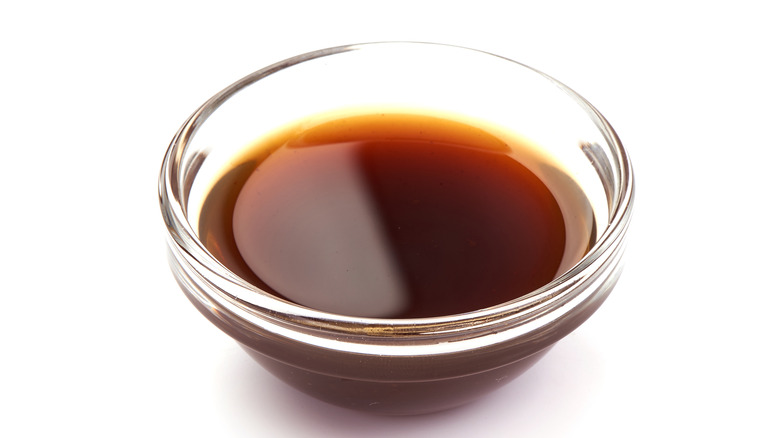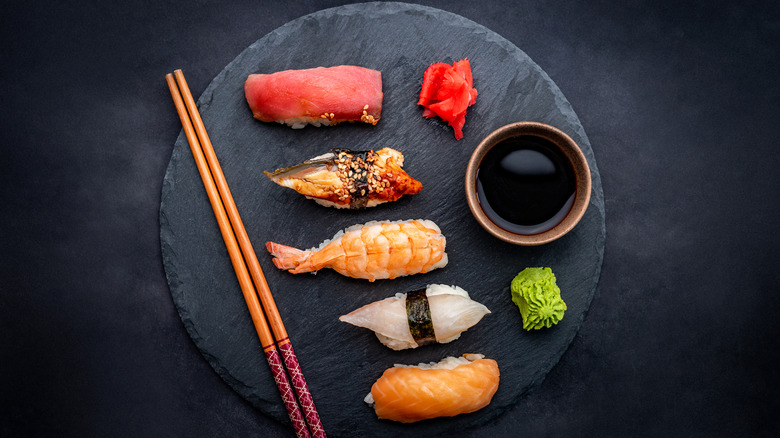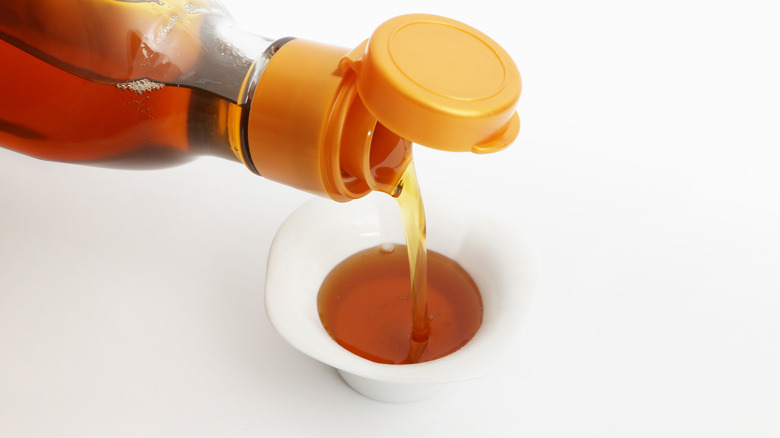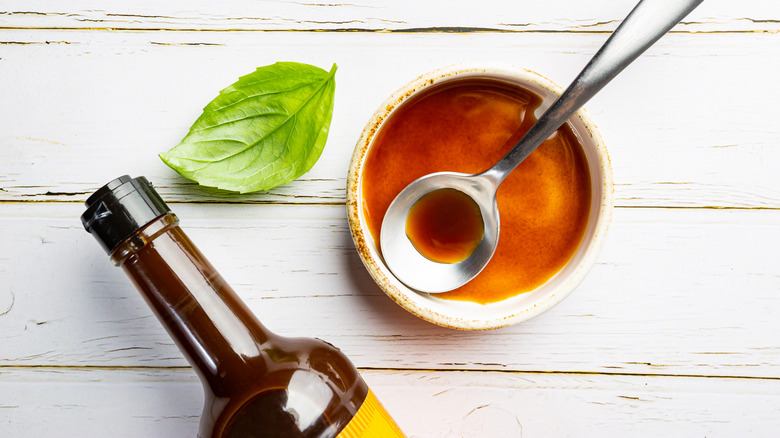14 Fish Sauces Around The World, Explained
Fish sauce, the condiment made from fermented anchovy, has more fans than some could probably imagine. While fish sauce is most popularly produced across Southeast Asia today, its roots are much deeper; traces of fish sauce can be found not only in China but in ancient Rome, where it was known as "garum."
The amber-colored liquid might not look like it, but fish sauce is exactly as advertised. Per the South China Morning Post, the pungent condiment is made by combining fish with salt, then allowing this mixture to sit for a few months to give the ingredients a chance to ferment and transform into the pungent, umami-flavored liquid prized by chefs around the world. Depending on its grade, fish sauce can be used as a dipping sauce, used to create marinades and condiments, or cooked into a meat or vegetable sauce.
There are so many kinds of fish sauces just in Asia alone, so we decided to take a look at many different kinds of fish sauces from around the world to help you decide which ones you want to try.
Nuoc mam
In Phu Quoc, which is off Vietnam's southwest coast, fish sauce is made in wooden barrels in a prized way. In Phu Quoc, manufacturers pride themselves on making fish sauce in the same way as Italians take pride in their olive oil. And, like the Italians, the Vietnamese have developed a grading system for their fish sauce. Good nuoc mam, the first fish sauce in question, should be so clear that it's transparent.
High-grade fish sauce is also represented by degrees (°N) on a label, per Hong Kong foodie Chan Tiu-Ming for Michelin. He explains the higher value sauces have more protein and umami, which drives the price up. Tiu-Ming explains that the high-value fish sauces deliver a ton of umami flavor and work best when they play a starring role in dipping sauces. The lower grades of fish sauce can be used for cooking since the protein found in the sauce is less sensitive to heat.
Nam pla
Most fish sauce sold in the United States comes from Thailand and is separated into different grades just like in Vietnam. Thai fish sauce, or nam pla, and its quality depends on the time of extraction, per Cook's Info. After the fish is caught, they are bundled into clay jars with sea salt and in alternating layers until the jars have been filled, and then left to ferment between nine to 12 months. Liquid is emitted as the fish decompose, and the first draw from these clay jars is considered to be the best fish sauce of the batch.
Once the premium sauce is drawn, salt water is added to the jars and then left alone for another two to three months before a second grade of sauce is drawn. There is a third grade of sauce too, and Cook's Info says a higher grade sauce can be added to more inferior versions of the product to improve the flavor. Thai and Vietnamese sauces of the same grade can be used interchangeably and in the same way, although be aware that Thai fish sauce can be saltier than the others (perhaps a quick taste test before dumping the bottle in your recipe would be wise).
Patis
Of the three southeast Asian countries that are known for their fish sauces, perhaps the least discriminating of the lot is the Philippines, whose fish sauce is graded not according to fermentation and extraction, but by brand. Philippines fish sauce, or patis, is made with round scad — which is a type of mackerel, per Fortuna Sea Products — and is not only used to make fish sauce but is cooked and consumed as a main dish, too. Fish sauce in the Philippines can also be defined as a by-product in the manufacture of "bagoong," or fermented fish.
Philippines fish sauce manufacturers appear to be less fastidious than their Vietnamese and Thai counterparts in the manufacture of fish sauce. With the lack of distinction in either grade or flavor, Philippines fish sauces are used interchangeably both as dipping sauces mixed with the local citrus fruit "calamansi" and in cooking.
Garum
Today, millions, if not billions, of people depend on fish sauce to season their daily meals. So where did this amber, liquid gold originate? The answer is garum; more specifically, garum made in the Roman Empire. Smithsonian Magazine explains that while the details of garum production are still murky, it is widely agreed upon that garum was a common ingredient in ancient Roman cuisine. Scientists have even recreated a recipe that they claim is 2,000 years old and calls for dill, coriander, fennel, and small fish to be fermented for around a week.
In Pompeii, an ancient garum workshop was uncovered, and six sealed clay basins were discovered to still have remnants of this historical sauce inside. All along the Mediterranean, from current-day Tunisia to France, garum remnants have been found, leading archeologists to believe that garum was a widely used and highly valued ingredient.
Some believe that garum will come back into popularity, especially as more chefs play with historical preparation methods and recipes. If you do get your hands on this historical sauce, you can be sure it will bring flavor and depth to any dish, just like its beloved sauce cousins around the world.
Ngan-pya-ye
Ngan-pya-ye, a Burmese-style fish sauce, is an essential condiment in traditional Myanmar cooking. Fish sauce is actually lower in sodium than salt, making it a great alternative for people conscious of their sodium intake. Fish sauce is also irresistibly umami, which means that it brings a lot of flavor to any dish and is perfect for stews, stir fry, and sauces, among other things.
One of Myanmar's most beloved breakfast stews, mohinga, celebrates Burmese fish sauce by marrying it with other delicious flavors like lemongrass and ginger. Mohinga, usually served with rice noodles, boiled eggs, and thickened with toasted rice, is a fantastically comforting and savory way to start your day. Fish sauce should also not be siloed into only southeast Asian cuisines. Fish sauces like ngan-pya-ye are incredibly versatile and useful in flavoring many dishes. They can bring savoriness to your sauces, gravies, soups, stocks, and much more.
Tuk-trey
Tuk-trey, literally meaning fish water, is an essential Cambodian ingredient that can be used to flavor seafood, meat, vegetables, stews, and really whatever you would like. Tuk-trey is so delicious that it has been made in Cambodia for generations, and many local regions have their own recipes. For small batches, 196 Flavors explains that small earthen jars are used to ferment the fish for 12 months or longer. For larger, commercial production, the fish are often fermented in large wooden vats, and the fish sauce is extracted from the bottom.
If you have ever had Cambodian food, you have probably had tuk-trey, and whether you were able to taste its distinctive fishy-saltiness, or it just brought a nice depth of flavor, fish sauce is a must-have pantry item. It makes fantastic sauces such as that for neorm sach moan, a divine Cambodian salad. Neorm sach moan features chicken, lettuce cups, rice noodles, and plenty of veggies. The best part? Neorm sach moan celebrates tuk-trey in the best way, by making it into a sweet, salty, acidic, umami, and spicy sauce. When you add fish sauce to your dishes, you are one step closer to hitting all five major tastes.
Padaek
Traditionally made from freshwater fish from the Mekong river, padaek is a necessary Laotian sauce that can be found in almost every household. Padaek is similar to tuk-trey and ngan-pya-ye in that it is made from fermented fish. Nonetheless, all of these sauces are different from one another, and padaek definitely has its unique traits. Namely, padaek is a type of unfiltered fish sauce, made into a fish-paste, fish-sauce hybrid. Padaek is made from pickled or fermented fish, and unlike other varieties of fish sauce, padaek is thick and sometimes contains bits of fish.
Padaek is boldly flavored, which in part can be attributed to its long fermentation time. While other types of fish sauce usually ferment for 12 months, padaek can ferment for anywhere from a year to five years. That means that the resulting padaek is thick, umami, and bursting with flavor. You can use padaek in a variety of dishes, such as soups and stews, and it is also traditionally a staple ingredient in the dressing for green papaya salad.
Yúlù
Before garum got to southeast Asia, it took a pit stop in China, where it was quickly adopted and is now known as yúlù. Yúlù is most commonly made from anchovies and salt, and is fermented for a long period of time until the precious fish sauce, or "fish dew," as yúlù translates to, is ready to be harvested. Yúlù is so delicious because it has a strong umami taste. The umami comes from yúlù's high levels of glutamate, which is also why some flavorings like MSG (monosodium glutamate), are also so irresistibly savory.
Chinese food varies greatly by region, and it may come as a surprise to some that yúlù is not actually that common throughout China. It is a very regional ingredient, concentrated in the southeast corner of China and enjoyed by the Chiu Chow, or Teochew, people.
Budu
Budu, another fish sauce cousin, is more similar to padaek because both are unfiltered, thicker versions of fermented fish. Another thing that sets budu apart is how it is used. According to Periuk, budu is not actually used as a cooking ingredient, but rather shines at the dining table. Used mostly as a condiment, budu is not often utilized in the actual flavoring of dishes and is instead a beloved dipping sauce for mackerel or the perfect addition to rice.
So where is budu from? This versatile and delicious condiment hails from the east coast of Malaysia, specifically the city of Kelantan. There, budu was initially created as a way to preserve anchovies once the fishing season came to an end. As per Periuk, budu means fermented anchovies, and therefore can only be made with anchovies. If freshwater fish is used, the resulting fermented condiment is called pekasam. It should come as no surprise that all around southeast Asia, there are many regional variations of budu. In the Pangasinan province of the Philippines, there is bagoon, while in the Bangka Belitung Islands of Indonesia, it is known as rusip.
Colatura di alici
Perhaps the closest fish sauce relative to the ancient garum, colatura di alici is the Italian version of fish sauce made from fermented anchovies. In the past, colatura di alici was made in the late spring during the fishing season and left to ferment until Christmas, when it was harvested for the winter. The city of Certara, a village along the Amalfi coast, is the birthplace of colatura di alici, and it was not until the 19th century that this prized sauce became widely known to the world, says Culinary Historians of New York. Since the commodification of colatura di alici, its production has become much less personal and familial and is now riddled with tourism, gastronomy, and the international spotlight.
Nonetheless, the truth remains that coltura di alici is a delicious ingredient that brings a delightful umami taste to dishes like pasta sauce and stews. Traditionally, colatura di alici is used in the winter, but today you can find it around the world at any time of year. If you are looking to stock up your pantry, make sure to buy DOP (Designation of Origin) colatura di alici. According to Culinary Historians, much of the colatura di alici available today is made improperly and is not at pungent and flavorful as it should be. Therefore, buying DOP colatura di alici ensures that you will be one step closer to obtaining the best there is.
Shottsuru
Unlike most types of fish sauce, shottsuru is not made from anchovies. Rather, it is made mostly from sandfish. Shottsuru, like other fish sauces, is incredibly regional and comes from the small city of Akita, Japan, located in the Akita prefecture, on the coast of the Sea of Japan. According to Kyodo Ryori, shottsuru is also fairly mild in flavor and smell, setting it apart from other types of fish sauce which can have distinctly strong scents. Part of this may be explained by the fact that shottsuru is traditionally made only from the white meat of sandfish. While most other fish sauces are made with non-white fish, using only white meat produces a more mild sauce that still has an impressive flavor.
Mr. Moroi, from Shottsuru Moroi Jouzoujo Co., explains that shottsuru is a fantastic flavoring for nabe, a Japanese hot pot, and is also becoming more common in other Japanese winter dishes. You can also use shottsuru to season onigiri or yakisoba and bring some irresistible umami flavor to your food.
Ishiru
Another type of Japanese fish sauce, ishiru is truly unique because it is not actually made from fish, but rather squid. Therefore, this seafood sauce, if you will, is a traditional ingredient from the Noto peninsula in Japan. According to Noto's Satoyama and Satoumi, ishiru is specifically from the east coast of the Noto peninsula, while the west coast specializes in a fish sauce made from sardines.
Ishiru is made from squid livers that are harvested, mixed with 30% salt, and left to ferment for seven to nine months. The final sauce is then collected, boiled, and strained so that it is pure and delicious for eating. The name ishiru comes from the two words io, meaning fish, and shio, meaning soup. Therefore, ishiru translates roughly to fish soup, (via Noto's Satoyama and Satoumi).
It should come as no surprise then that ishiru is delicious in soup. A great ingredient for soups, stews, and broths, ishiru brings salty and savory elements to many dishes. It is also commonly used in place of soy sauce, especially for sashimi.
Aekjeot
Aekjeot is actually an umbrella term for many varieties of Korean fish sauce. According to My Korean Kitchen, there is myulch aekjeot, made from anchovies, kkanari aekjeot, made from sand lance, and saeujeot, which is made from shrimp. These sauces are essential in Korean cuisine, and we can thank them for many of the umami flavors that we love. All of these variations also set aekjeot apart from many of the fish sauces found in southeast Asia. While nuac mam and tuk-trey are almost exclusively made from anchovies, aekjeot is more versatile in construction and flavor. This also means that each variety of aekjeot is perfect for a variety of dishes, making it versatile and adaptable to any palate.
Aekjeot is a staple ingredient in one of the most well-known Korean dishes, kimchi, and it lends it its signature salty flavor. Maangchi explains that good aekjeot should be salty, umami, and a little bit sweet, making it an essential pantry item and a great substitute for soy sauce, dashi, or salt.
Worcestershire
When the British invaded and colonized India, many of the world's food cultures were changed forever. One consequence of that was the creation of Worcestershire sauce. Lord Sandys, a prominent British baron, requested his favorite Bengali sauce be made for him in England. The sauce was thought to have been a disaster and was forgotten about in the cellar. Years later, the sauce was re-discovered, and much to everyone's delight, the flavor had mellowed and become quite enjoyable. This was the beginning of Worcestershire sauce.
But how exactly is Worcestershire sauce fish sauce? Well, the original sauce that Lord Sandy's requested was an anchovy sauce, so to this day, much of the savory, salty flavor of Worcestershire sauce is thanks to fermented anchovies. In addition, Worcestershire sauce has tamarind, which adds layers of sweetness and tang. Worcestershire sauce makes a great marinade, and, like other fish sauces, brings a great burst of umami and salt to stews and meat.
